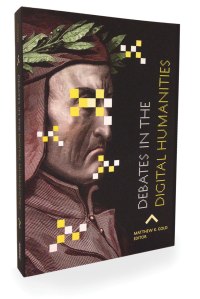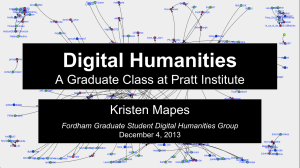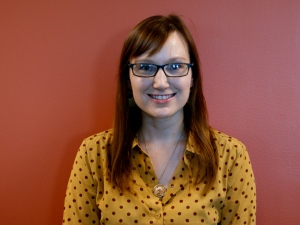 When I registered for a dinner discussion with Miriam Posner at Fordham University’s Lincoln Center campus, I did not expect brains would be on the menu. Posner’s talk, an aperitif to her forthcoming book, Depth Perception: Narrative and the Body in American Medical Filmmaking (under contract with University of North Carolina Press), lingered on early twentieth-century lobotomies, as participants raised pointed questions about the process and documentation of Walter Freeman’s many lobotomies (reference The Lobotomy Letters or The Lobotomy Files). Yet, despite the curiosity of these surgeries, lobotomies provided but a frontal lobe to Posner’s expansive presentation. As the title of her talk suggests, “Thinking Through and with Text: Designing Digital Humanities Scholarship for the Screen” was as much about how scholars today re-present scholarship via electronic platforms as it was about how surgeons captured and represented bodies in medical films. With this post, I want to raise two related questions that, in the second half of the conversation, divided participants: What should a user interface do, and what is its relation to a narrative?
When I registered for a dinner discussion with Miriam Posner at Fordham University’s Lincoln Center campus, I did not expect brains would be on the menu. Posner’s talk, an aperitif to her forthcoming book, Depth Perception: Narrative and the Body in American Medical Filmmaking (under contract with University of North Carolina Press), lingered on early twentieth-century lobotomies, as participants raised pointed questions about the process and documentation of Walter Freeman’s many lobotomies (reference The Lobotomy Letters or The Lobotomy Files). Yet, despite the curiosity of these surgeries, lobotomies provided but a frontal lobe to Posner’s expansive presentation. As the title of her talk suggests, “Thinking Through and with Text: Designing Digital Humanities Scholarship for the Screen” was as much about how scholars today re-present scholarship via electronic platforms as it was about how surgeons captured and represented bodies in medical films. With this post, I want to raise two related questions that, in the second half of the conversation, divided participants: What should a user interface do, and what is its relation to a narrative?
Posner discussed a number of existing digital projects that showcase the “affordances and opportunities of digital publishing.” She described the Negro Travelers’ Green Book Map in relation to three main considerations: sources, processing, and presentation. Beginning with the Green Book, a directory of “safe” destinations for African American travelers during the Jim Crow era (source), scholars scanned, geo-located, and built a database of destinations (processing), and mapped and made that data searchable (presentation). While the Green Book Map was a crowd-pleaser, subsequent projects tested the audience’s open-mindedness about interface design. For example, Posner introduced the multimodal journal Vectors. In concept, the audience embraced the proposition (judging by head nodding), but as soon as Posner opened the Vectors editors’ statement, brows furrowed. Here was a page that purported to speak (a statement of intent), but that required the user to pose a question (a keyword search). What did readers have to do to access the entire statement? Whereas some members of the audience rejoiced in the “problem” that the code suggested, others simply wanted to read to the statement. A glance at N. Katherine Hayles’ Narrating Bits exacerbated the divide. One participant asked, “Who uses it?” “What if interfaces aren’t for use, but for something else entirely?” Posner rejoined.
We discussed several other projects that underscored the diverse uses of digital interfaces. Whereas The New York Times’ Snow Fallemploys an immersive interface that absorbs the reader in a multimedia report on an avalanche, Eric Loyer’s Freedom’s Ring (built in Scalar, the new Vectors’ CMS) enables readers to either follow a prescribed narrative or chart their own paths through its nodes. The defamiliarizing interface of Whitney Trettien’s Plant -> Animal -> Book, meanwhile, requires readers to explore content—and the act of reading—associatively.
If one takes seriously the proposition that user interfaces are more than transparent views of content (Johanna Drucker), Posner’s talk underscores the potential of interfaces to function as windows, walls, mazes, and gateways. I want to think about the relation of interfaces to narratives. Like many students of the humanities, I enjoy a good story. The question is whether writers or scholars ought to, given the availability of flexible electronic platforms, enable readers to construct their own narratives by means of different interfaces.
In our conversation with Miriam Posner, several participants argued interfaces are inherently coercive because they require somatic engagement with prescribed routes (e.g., Scalar’s linking and forking paths). However, I fail to see how the narrative of a digital text is any more coercive than that of certain print novels. The frustration that participants expressed about their inability to read the Vectors editors’ statement is not unlike from the frustration readers value in difficult novels such as Gravity’s Rainbow, Finnegan’s Wake, and Pale Fire. We prize the challenges of those novels and how they coerce us into becoming conscious of how we read.
The issue, as I see it, is not that digital texts are inherently more coercive than print counterparts, but rather that they provide an illusion of control. This issue is only a problem if the reader is recast as writer. Electronic interfaces are worth evaluating critically because they enable writers to cast the seedlings of multiple simultaneous narratives. Interfaces that allow readers to chart different paths through content (such as those built with Scalar) may not allow readers to inscribe their own narratives, but they enable readers to discover other narrative germinations. Those discoveries, coerced as they may be, belong to readers in much the same way as does understanding wrested from an oblique print narrative. In this context, perhaps interface will entangle with narrative and the act of reading, its form, akin to the human brain, replete with unseen passageways, unexpected barriers, and unforeseeable possibilities.



